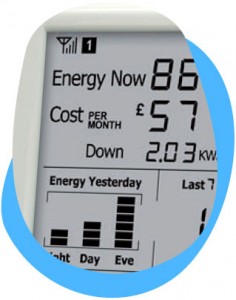What is a home energy monitor?
Home energy monitors are wireless devices that transmit information from your meter to a small portable display. You can then tell at a glance, the amount of electricity, and sometimes gas, being used, how much it’s costing and often how much C02 is being emitted. Also referred to as a ‘real time display’ or ‘RTD’, there are now lots on the market costing from around £20 to £80. A few models use rechargeable batteries, but most run on 4 or 6 AA batteries.
 How do energy monitors work?
How do energy monitors work?
Most monitors on the market involve clipping a transmitter around the cable of your electricity/gas meter. The current is then measured and transmitted wirelessly to a display screen that you can put anywhere in your house. To set the monitors up you need to enter details of your unit rate of electricity (found on your bill) and remember to update it with any changes to the tariff.
How much electricity can I save?
Energy monitors alone don’t save you any cash; the savings come by becoming aware of the electricity you are wasting and changing your habits. A bit like going on a diet – you need to be motivated to make it happen and to sustain it. In trials of home energy monitors, customers reported savings of between five and 15 per cent in the first year of owning one, which could result in savings of £25 to £75 off a £500 bill. Estimates by the Energy Saving Trust show that households in the UK waste around 8 per cent of their electricity bill on standby power, equivalent to around £40 a year for an average household. And, reportedly, £170 million a year is wasted through leaving lights on in unused rooms. (although I’m not sure how they know this).
Is it worth buying a home energy monitor?
Knowing how much energy your home appliances are using is great if it helps you save cash, and reduce your carbon footprint. Beware though, you could become an energy bore. Reeling off how many kilowatts it takes to boil a kettle or run the fridge, over the dinner table, can get a bit tedious. And once the novelty of the monitor has worn off, will you change your energy using habits, or will it be left to gather dust or relegated to the kitchen drawer along with the cappuccino frother and the electric garlic press? True to say, if owning a monitor makes you change your habits long term, and, assuming you don’t live in a house full of teenagers incapable of switching lights off, you could save money – reportedly, up to 15% or £135 off the average annual bill.
There are some deals available with energy suppliers offering monitors free with certain tariffs, but beware you could be paying over the odds for the tariff. Check out the cheapest tariff first and buy a monitor separately. It’s also worth checking with your local library if they have energy monitors available on loan. Or save the cash and look at the dial on your meter spinning around in the cupboard! And remember to buy energy efficient appliances when you need to replace old ones.
Smart Meters are on the way
A government backed nationwide roll-out of smart meters started in 2012. This effectively banishes your energy monitor to the kitchen draw! It estimates that around 26 million households will be fitted with a smart meter by 2020. The real time data monitoring that smart meters will provide is going to be very beneficial in helping consumers track household energy consumption for free, as well as helping energy suppliers identify areas where the climate change battle can best be fought.